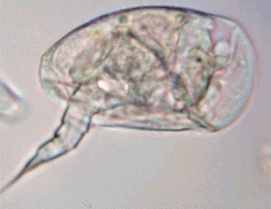Collurella which is small in size; sometimes smaller than paramecia! (Don't confuse with Lepidella.)

|
The fascinating world of rotifers (PAGE 2) |
By Jean-Marie Cavanihac France |
|
Collurella which is small in size; sometimes smaller than paramecia! (Don't confuse with Lepidella.) |
|
|
Another rotifer species found in a marine sample: Hexarthra, which is difficult to observe because it 'jumps' using its appendages (seen at the top of the picture). |
|
|
|
|
Trichotria has a forked tail with two spines near its base (picture taken with x15 objective). |
|
Trichocerca, with an elongated mastax (picture taken with x40 objective). |
|
|
|
|
Monomata with two appendages looking like feathers! (x 6,3 objective) |
|
Habrotrocha which seems to have two little 'eyes': the red spots are best seen in the inset detail. (Inset taken with x40 objective; main picture taken with x15 objective. |
|
|
|
|
Cephalodella (X40 objective). |
|
Squatinella, another very small rotifer, (picture taken with x15 objective). |
|
|
|
Limnias mélicerta; this is in the same family as Floscularis and lives in a protective tube (X15 objective). |
|
|
|
|
Anuraeopsis fissa with its large egg! (x40 objective). (Thanks to Walter Dioni for his help with the identification.) |
|
|
|
Last but not the least : intriguing Colotheca. Probably the most beautiful! It doesn't possess a ciliated crown but a sort of net made with tiny tentacles. It's a little difficult to find among plants because it doesn't move! Note the single egg on its foot. Below is an animated view when deploying the net .. (x15 objective). Click here for an animated gif showing how Collotheca deploys its net (x15 objective)
|
||
|
|
|
|||
|
|
That's all for today! I hope this gallery gives Micscape readers the desire to go and search for other specimens of this great family and to observe them, including their reproductive process, feeding .... and the many interesting things about these fascinating creatures. More than 2000 species of rotifers exist! At the foot of the page below, are some interesting links to web resources about rotifers. NB: All the pictures were made using LIVING specimens (although the picture quality may be not as good) and which were replaced into the sampling jar ... |
|
|
http://www.microscopy-uk.org.uk/mag/wimsmall/rotidr.html http://ebiomedia.com/gall/rotifers/rotifermain.html (BioMEDIA galleries 'Whirling animals'.) http://spark.nasa.utep.edu/~rotifer/servlet/rotifersearch.search_editor (Rotifer systematic database, Univ. of Texas at El Paso.) http://data.acnatsci.org/biodiversity_databases/rotifer.php/types (Academy of Natural Sciences, Philadelphia, USA. Rotifer type specimens database.) |
||
|
Comments to the author Jean-Marie Cavanihac are welcomed. Microscopy UK Front Page
All drawings and photographs © Jean-Marie Cavanihac 2004 Published in the March 2004 edition of Micscape Magazine. Please report any Web problems or offer general comments to the Micscape Editor, Micscape is the on-line monthly magazine of the Microscopy UK web |